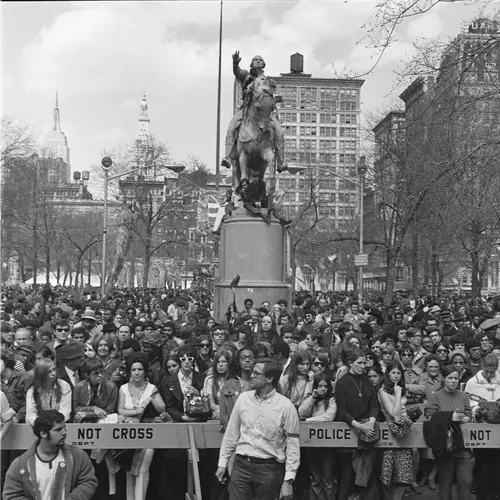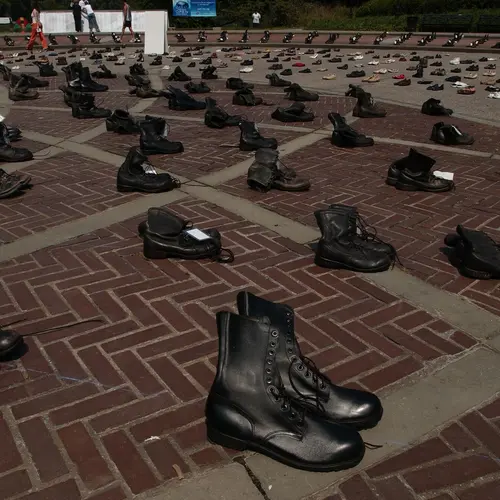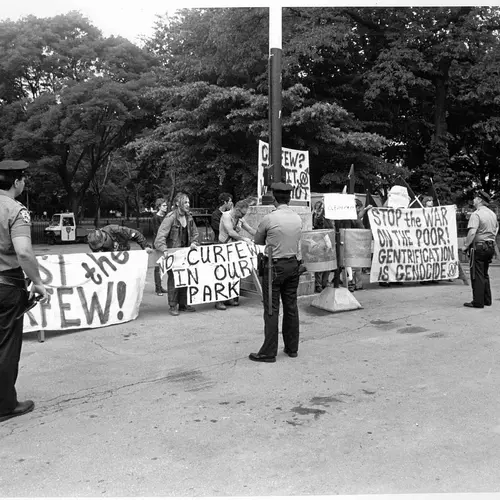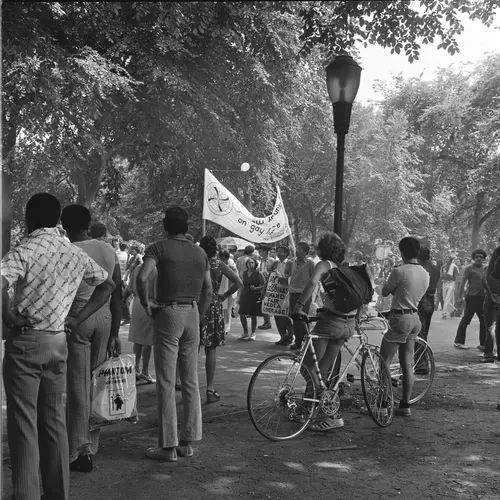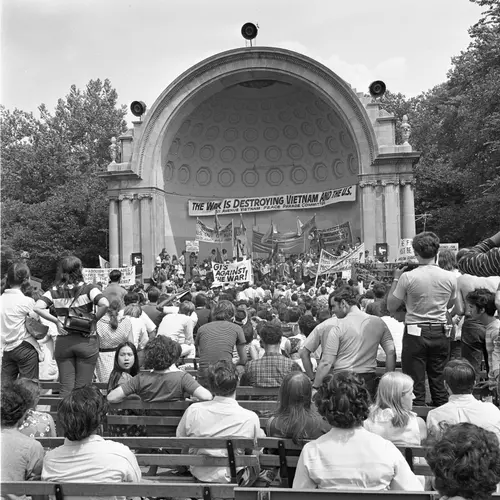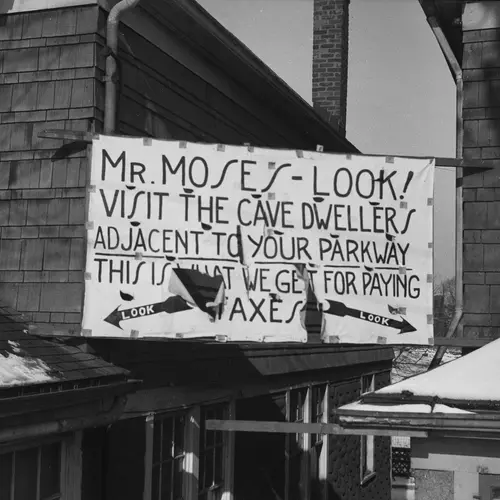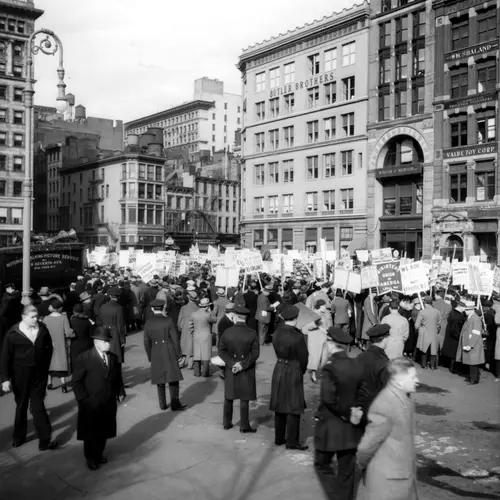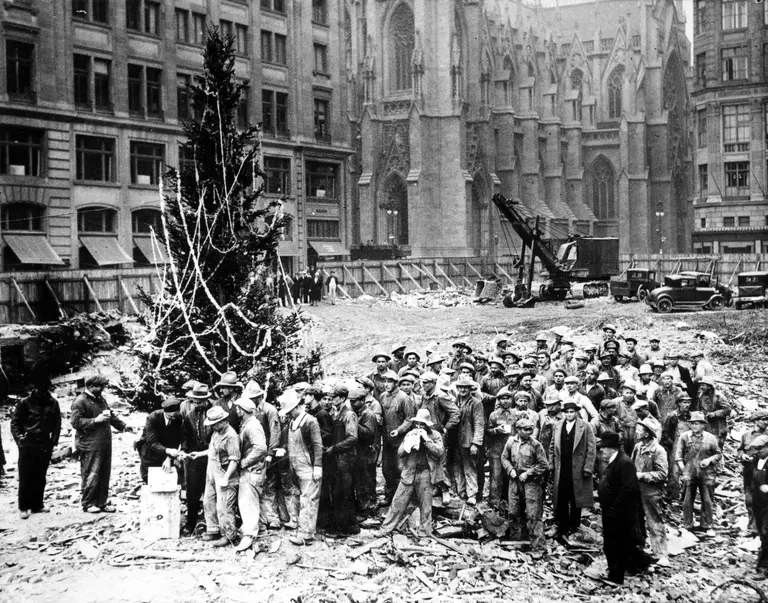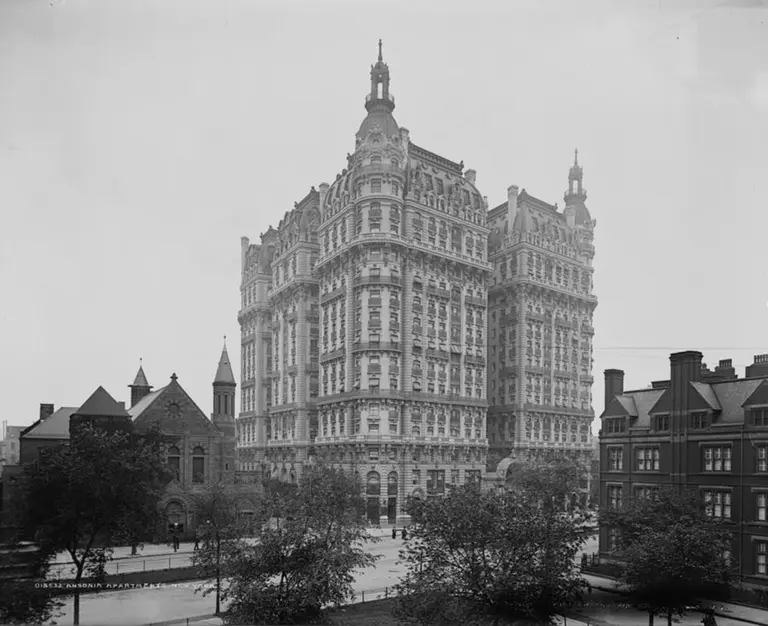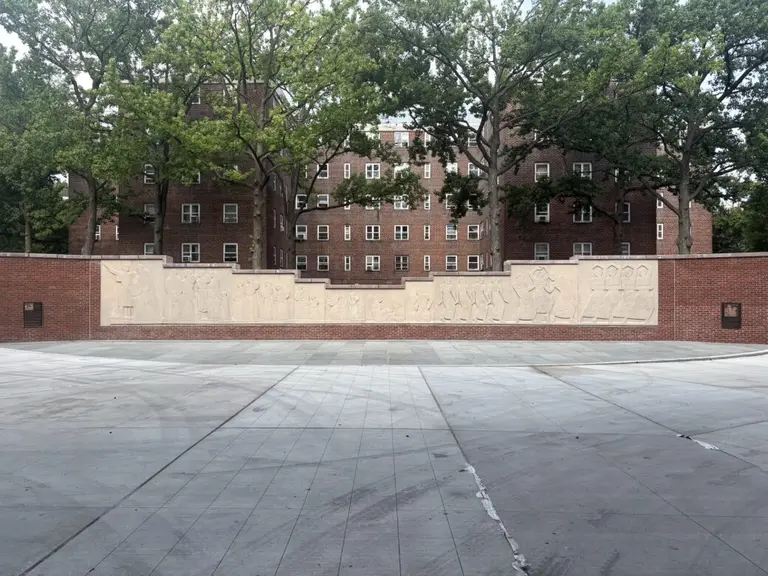Power to the people: Looking back on the history of public protests in NYC Parks
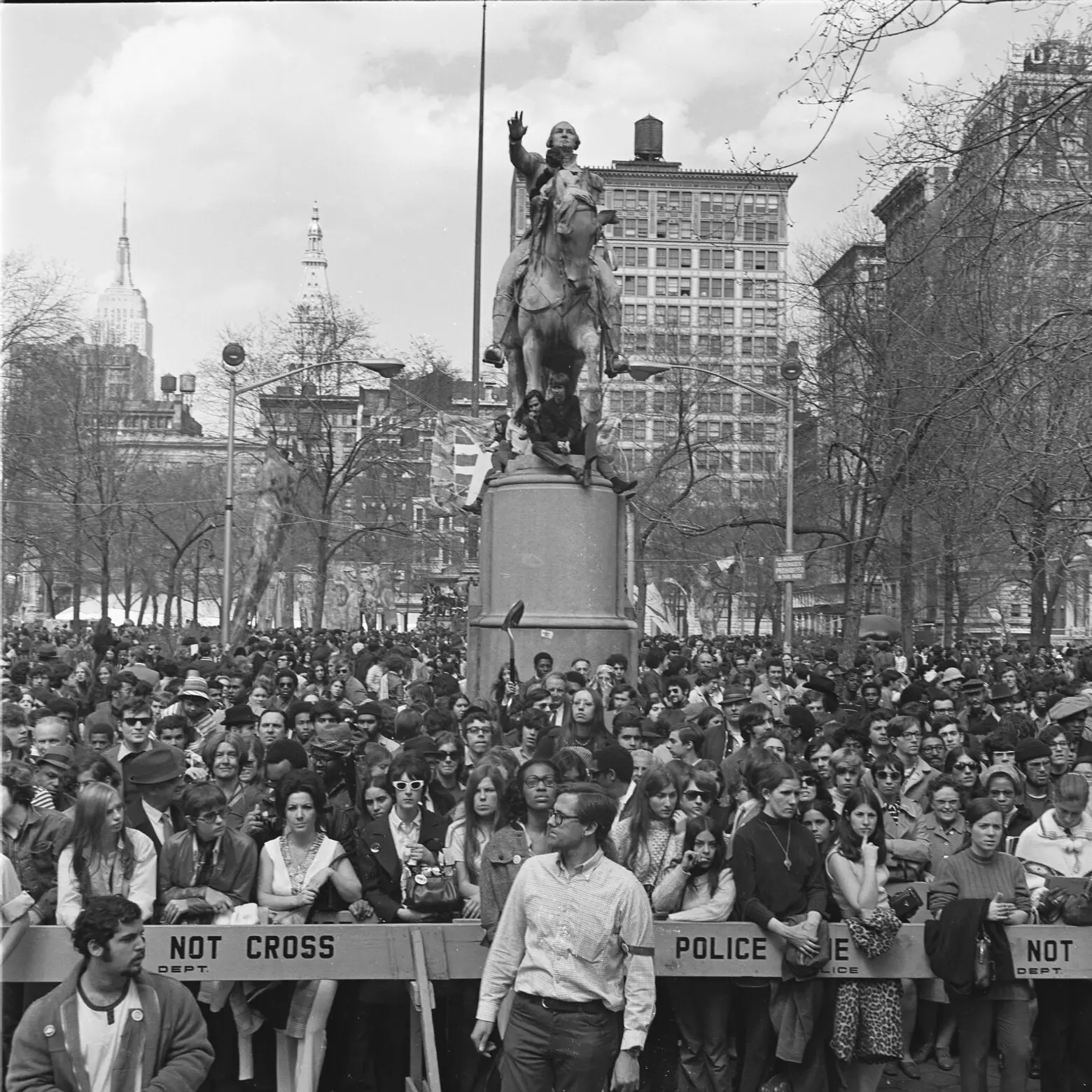
First Earth Day, April 22, 1970. View of crowds in Union Square, NYC Parks Photo Archive, Neg #53262_28. All of the photos in this post are courtesy of the Parks Department.
Maybe you’ve gathered in Union Square. Perhaps you’ve marched up Fifth Avenue to Central Park. You could have even held signs aloft in Columbus Circle, Tompkins Square, or Zuccotti Park. If you have ever been part of a protest in any park across the five boroughs, you’re in good company. New York City’s parks have a rich history of social protest that stretches back to the American Revolution.
Today, the NYC Parks Department’s Ebony Society will kick off a celebration of that history with “Power to the People,” which will feature archival photographs alongside mixed-media art on the theme of public demonstration. To celebrate the exhibit, we checked out the history behind some of the protests highlighted in the show.
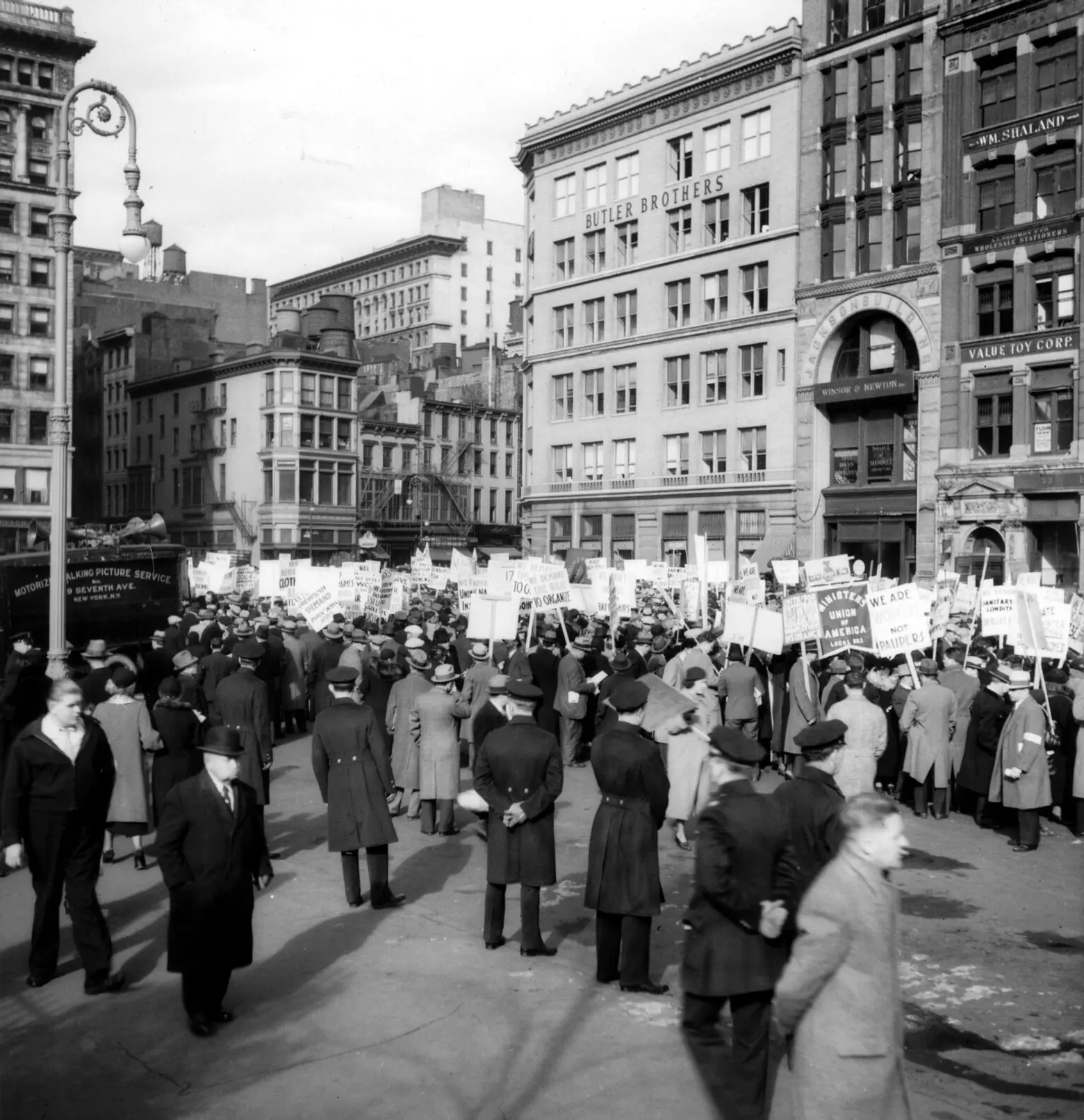
Photo with barricading policemen in foreground, E 17th St near Broadway, NYC Parks Photo Archive / Alajos L. Schuszler, Neg#4476
1. Union Square, Mass rally of the jobless, November 24, 1934
On November 24, 1934, in the depths of the Great Depression, 3,000 unemployed people gathered in Union Square under the auspices of the Unemployed Workers Union. The Union Square protest was one of several held in 23 states that day, in solidarity with the National Action Committee. In Union Square, the demonstrators called for “unemployment insurance and jobs instead of inadequate relief.”
The crowd, “tired of flop houses and breadlines,” was not interested in charity. They wanted the dignity and security of gainful employment, and steady pay. To advocate for it, they formed a parade in Union Square, and marched up to the TERA (Temporary Emergency Relief Administration) offices at 79 Madison Avenue. There, they advocated for clothing, medical supplies, and food before moving on to the Public Welfare Department at 902 Broadway and back down to Union Square.
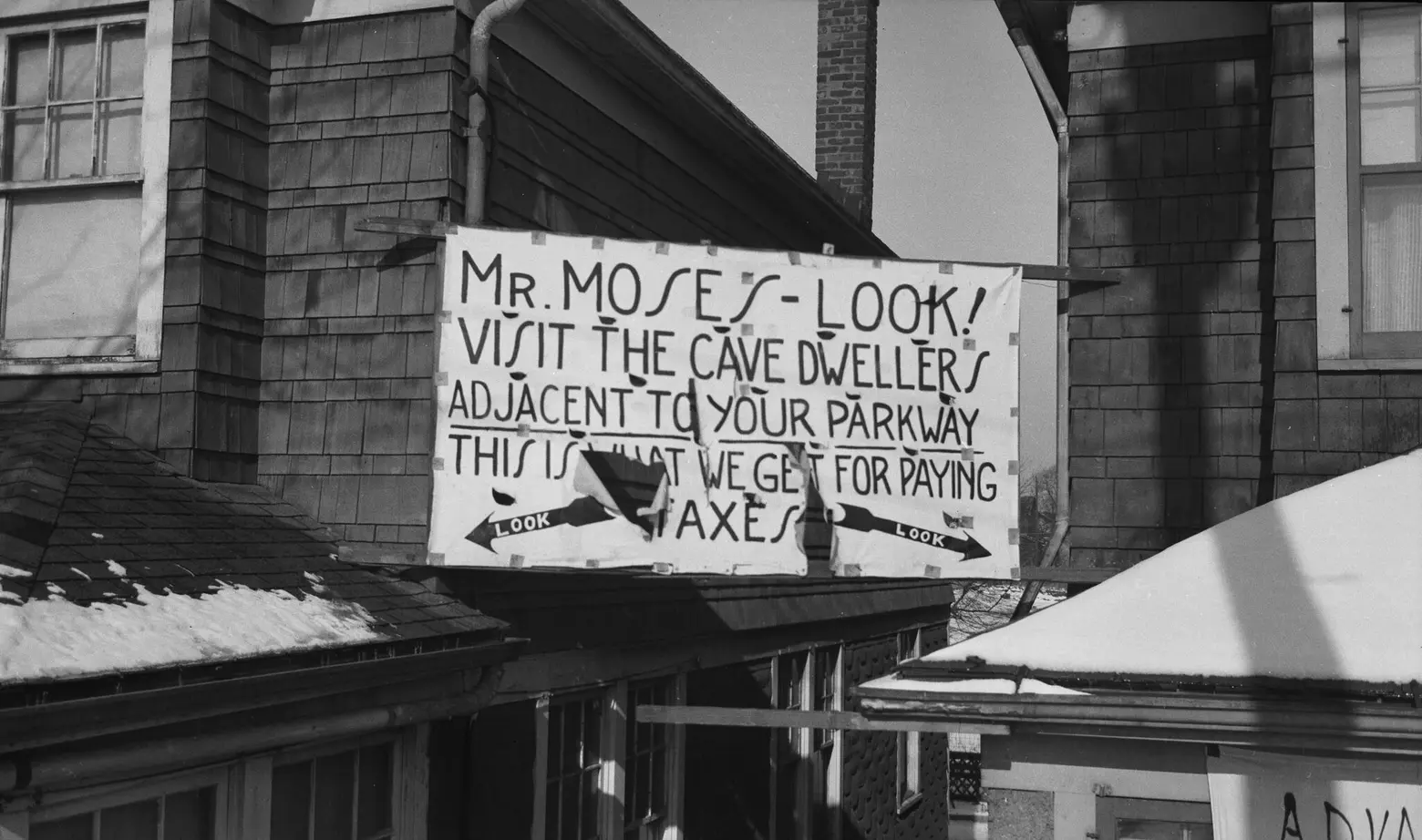
Photo near Lefferts Ave, January 16, 1940, NYC Parks Photo Archive, Neg #18184
2. Protest against Robert Moses building the Southern Parkway
Robert Moses may have thought that his Southern State Parkway, built as a conveyance to Jones Beach, was a great boon to the city, but the middle and working-class residents of the neighborhoods he leveled to give his road the right of way, were left cold. On January 16, 1940 residents near Lefferts Avenue protested the arrival of the parkway in their neighborhood.
Once the Parkway was built, those same residents were unable to use it, since it was built only for private cars. The New Yorkers who relied on mass transit were out of luck. Moses made sure they could not reach Jones Beach: he built bridges across his parkways that did not provide clearance for public buses.
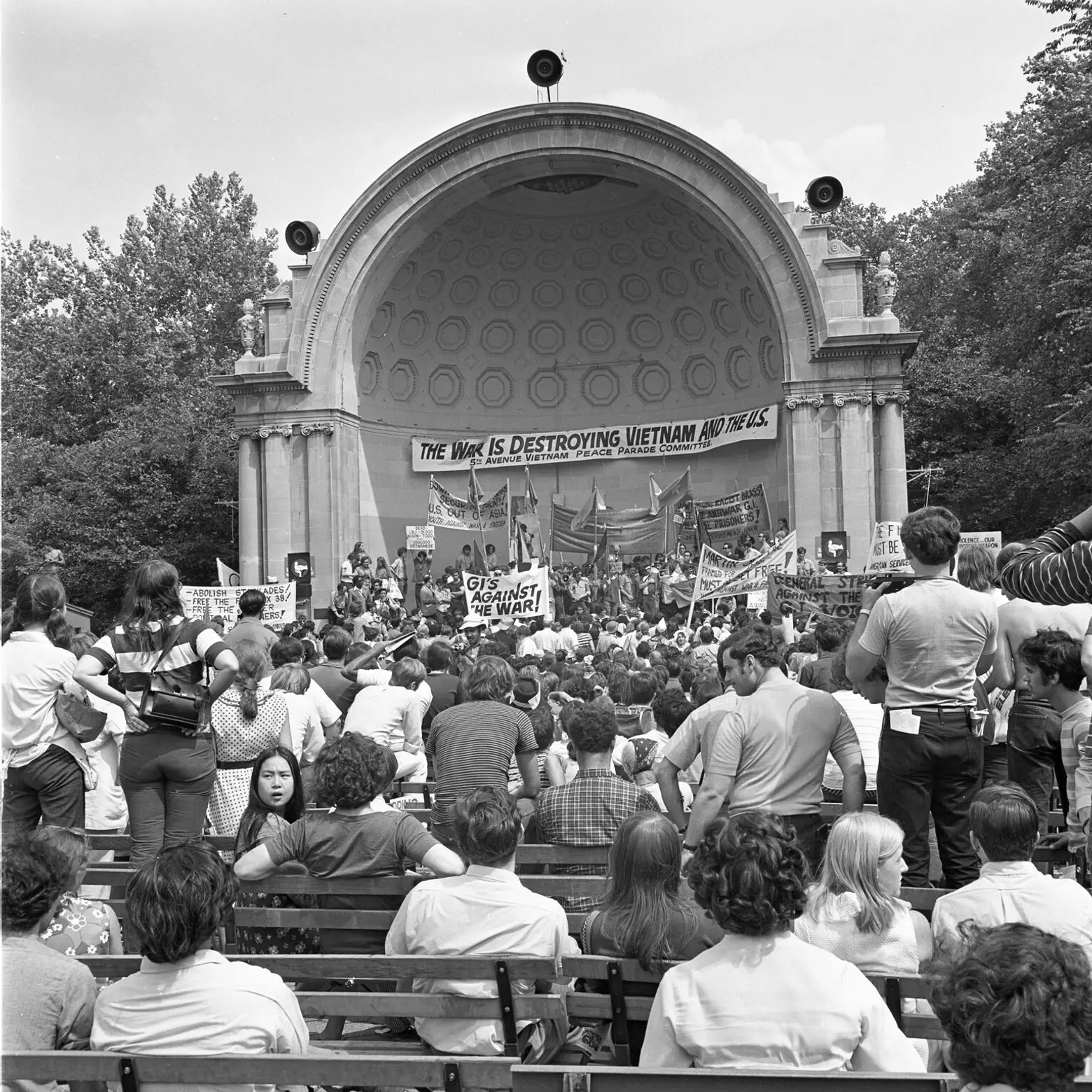
Photo at Central Park, Naumburg Bandshell, Vietnam War Protest, NYC Parks Photo Archive, Neg # 53132_01
3. Central Park, Vietnam War Protest, August 9, 1969
On August 9, 1969, 5,000 people gathered at the 71st bandshell in Central Park to mark the 24th anniversary of the bombing of Nagasaki with a peace rally against the war in Vietnam. The peace parade began at 41st and Broadway. From there, 2,500 people marched up 7th Avenue to Central Park, where the protest doubled in size. One rallying cry amongst demonstrators was “The park belongs to the people!” But, the main focus of the event was to “Bring all the GIs and the money home now,” and to “remove US military bases from Japan and Okinawa.”
The protest was not entirely peaceful. A faction of more militant protestors, which the New York Times referred to as “crazies,” resisted the leadership of the Fifth Avenue Vietnam Peace Parade Committee with banner polls they used as clubs. The Times termed the situation “a fracas,” which was only restored to order by the arrival (and apparently calming presence) of Allen Ginsberg.

Marchers and Onlookers, Central Park, NYC Parks Photo Archive, Neg # 53227-3
4. Central Park, Gay Pride Rally, July 1975
The very first Gay Pride Parade took place in New York City on June 28th, 1970, marking the 1st anniversary of the Stonewall Riots. That first parade was officially called “Christopher Street Liberation Day.”
While today’s pride parades make their way south, early parades went north from the Village to Central Park. In 1975, the parade route went from Christopher Street, through the West Village, up 6th Avenue, to the Park.

First Earth Day, View of crowds in Union Square, NYC Parks Photo Archive, Neg #53262_28.
5. Union Square, First Earth Day, April 22, 1970
The New York Times called the first celebration of Earth Day, April 22, 1970, the “largest demonstration ever organized to protest the degradation of the environment.” It was a “commitment to make life better, not just bigger and faster,” and to “re-examine the ethic of individual progress at mankind’s expense.”
Demonstrations were held all over the country. In New York City, 14th Street became the center of the action. The street was closed to traffic between 3rd and 7th Avenues, and was overcome by crowds. Fifth Avenue was also closed to traffic between 14th and 59th Streets for two full hours. The street closures had crowds so euphoric, that speakers in Union Square called for the banning of all cars in “Manhattan’s Central Business District” by 1972.
The day was marked by so much fanfare that there were three separate rallies in Union Square (at Noon, 3pm and 5pm), where speakers included Mayor Lindsay and Margaret Mead, while Leonard Bernstein, Paul Newman, Dustin Hoffman, Pete Seeger and the cast of “Hair” all provided entertainment. In summation, the New York Times surveyed the joyous scene and reflected, “If the environment had any enemies, they did not make themselves known.”
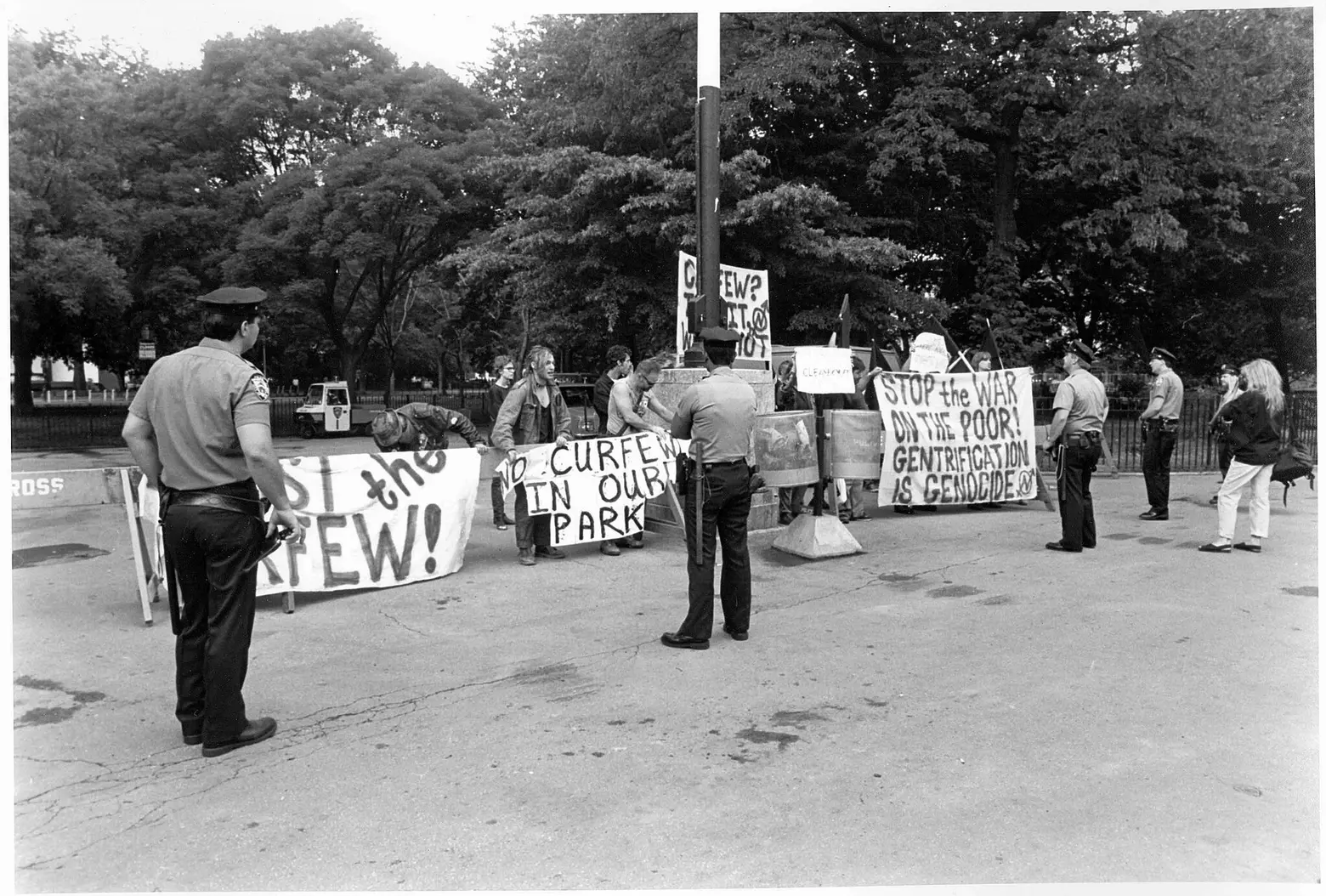
Protesters, NYC Parks Photo Archive, Neg # 60824-1
6. Tompkins Square Park, North Playground Renovation Protest, July 2, 1990
Tompkins Square Park has a long history of protest. Since the 1850s, when working men and women gathered in Tompkins Square to organize for public relief, the park has been a community hub. By the latter half of the 20th century, the park spelt not only community, but “home” for homeless New Yorkers who created “tent cities” in the park, and squatted in the abandoned buildings that dotted Alphabet City.
By the late ‘80s the NYPD regularly dismantled the make-shift homes that sprang up in Tompkins square, and in 1990 and 1991, the city imposed a curfew on use of the park, and even chose to close it entirely. While the city maintained that it wanted to close the park in order to renovate it for the good of the neighborhood’s residents, those residents took to their park in protest.
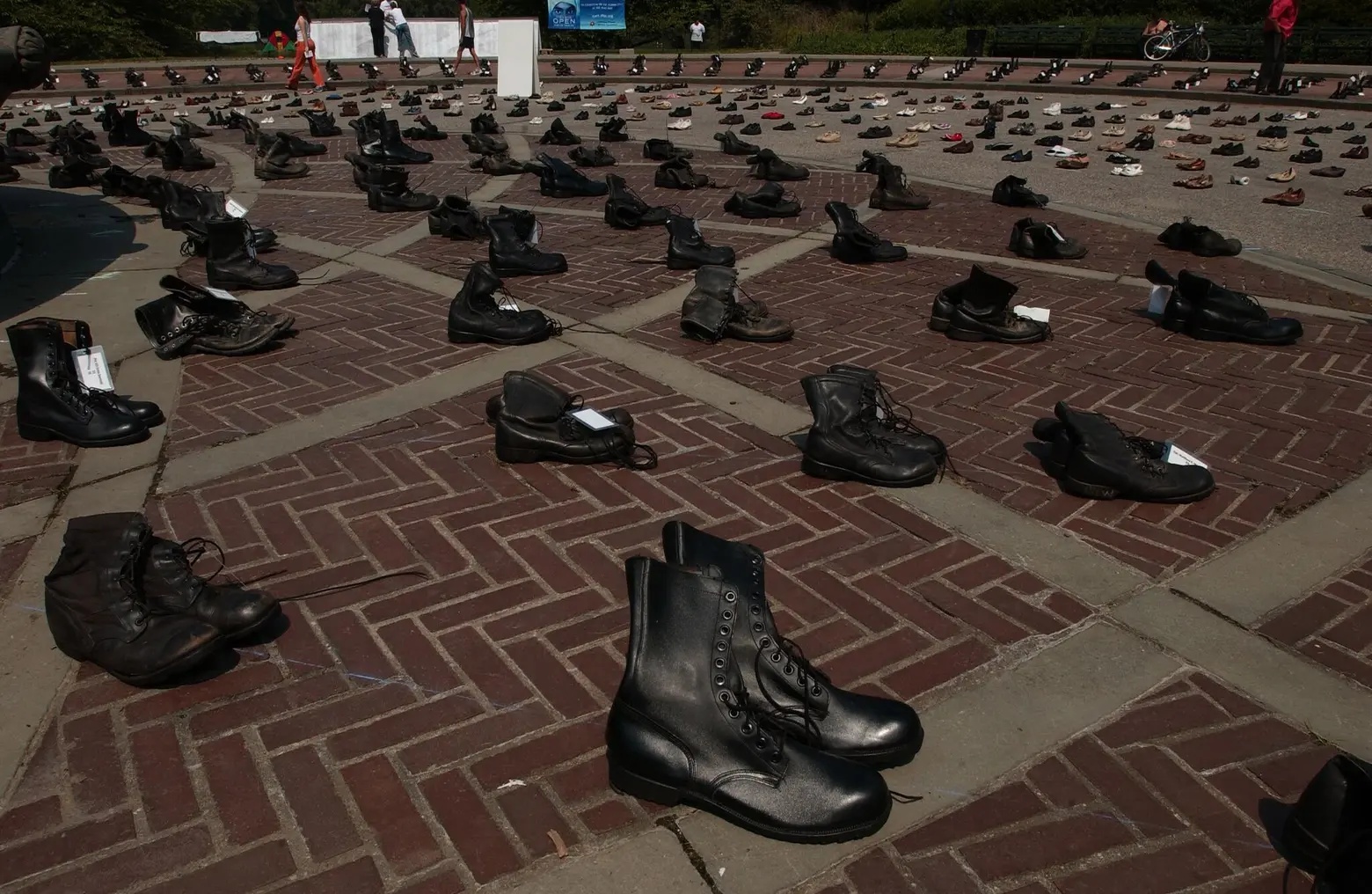
Malcolm Pinckney/NYC Parks
7. Central Park, Cherry Hill Anti War Protest, August 28, 2004
In August 2004, when the Republican National Convention made landfall at Madison Square Garden, nearly half a million people took to the streets. While major political protests are de rigueur in New York today, the “roaring two-mile river of demonstrators” that “surged through the canyons of Manhattan,” marked the city’s then-largest political protest in decades. After a 6-hour march from Chelsea to Midtown, and back down to Union Square, under the banner of the organization “United For Peace and Justice,” thousands gathered peacefully on Central Park’s Great Lawn.
The demonstrators had not been granted a permit for the park, on the grounds that their presence might damage the grass on the Great Lawn, but protestors maintained that it was “free speech and not the grass being trampled.” The New York Times held that “trouble had widely been expected” in Central Park, but the scene remained peaceful on the part of both protestors and police.
In other parts of the park, a symbolic protest highlighted not the crowds of protestors gathered on the Great Lawn, but the servicemen and women who were not there. On Cherry Hill, shoes with no one to fill them made a haunting memorial to and protest against the war in Iraq.
+++
“Power to the People” is free and open to the public. It will run through February 28th in celebration of Black History Month.
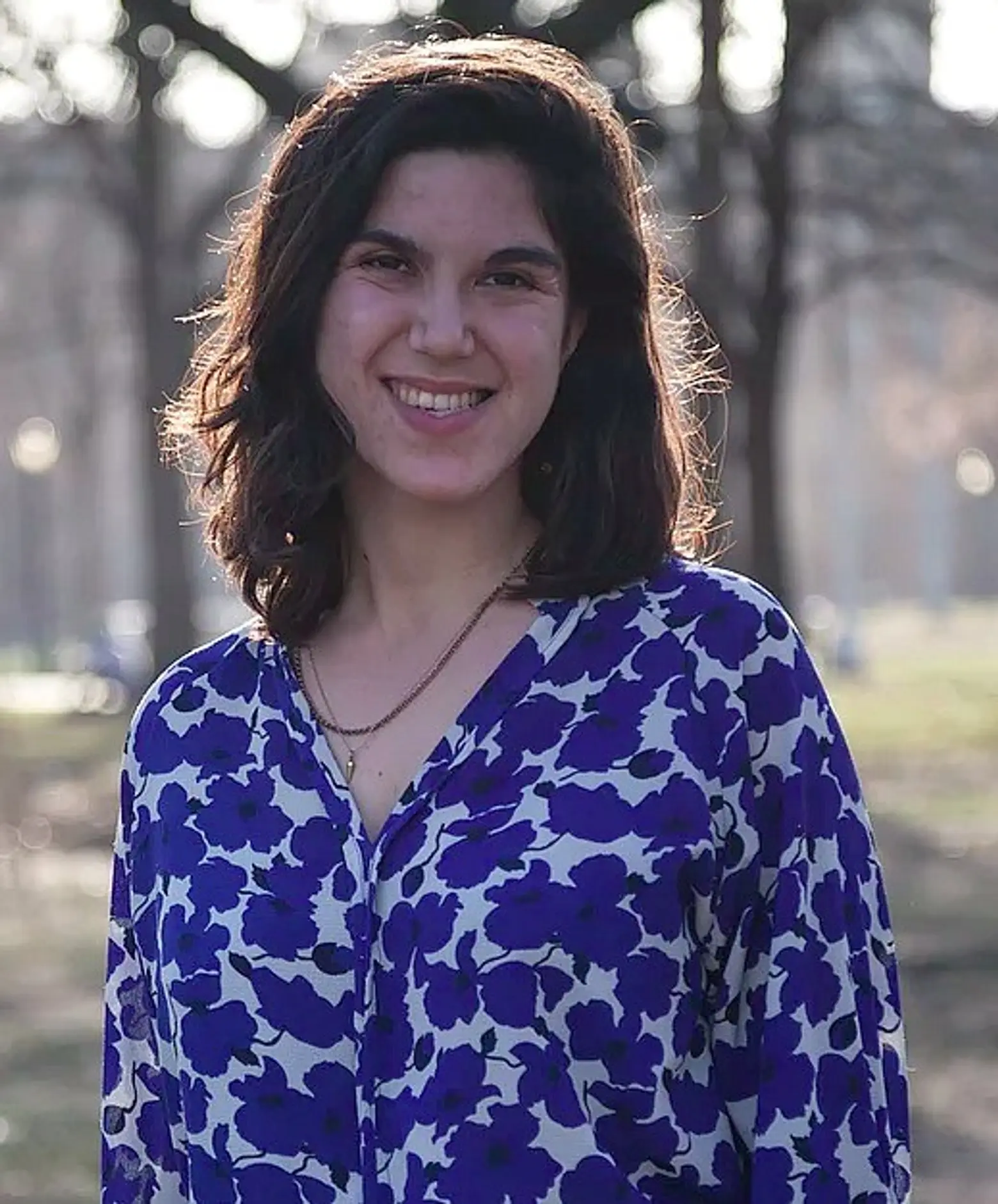 Lucie Levine is the founder of Archive on Parade, a local tour and event company that aims to take New York’s fascinating history out of the archives and into the streets. She’s a Native New Yorker, and licensed New York City tour guide, with a passion for the city’s social, political and cultural history. She has collaborated with local partners including the New York Public Library, The 92nd Street Y, The Brooklyn Brainery, The Society for the Advancement of Social Studies and Nerd Nite to offer exciting tours, lectures and community events all over town. Follow her on Twitter and Instagram.
Lucie Levine is the founder of Archive on Parade, a local tour and event company that aims to take New York’s fascinating history out of the archives and into the streets. She’s a Native New Yorker, and licensed New York City tour guide, with a passion for the city’s social, political and cultural history. She has collaborated with local partners including the New York Public Library, The 92nd Street Y, The Brooklyn Brainery, The Society for the Advancement of Social Studies and Nerd Nite to offer exciting tours, lectures and community events all over town. Follow her on Twitter and Instagram.
